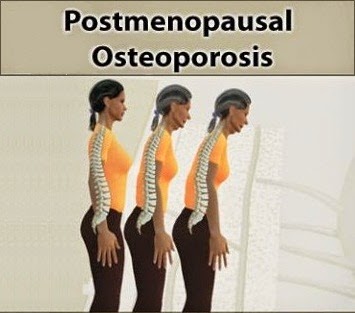Osteoporosis and Menopause. Many of you may think what is the relationship between them. One is a bone illness and the other is a hormonal issue, natural in the way the woman’s body develops at old age.
Thus, what is the connection between these two?
Menopause usually occurs at the age of 45 and 55. At the same time, the level of the hormone named estrogen drops also, leading to an increase in the loss of bone mass of a woman.
Studies show that a woman will loose on her five years after starting of menopause up to 10% of her bone mass. Thus, being more vulnerable in the way of osteoporosis.
 |
| Deterioration of Vertebral Support due to Postmenopausal Osteoporosis |
Relation between estrogen and osteoporosis development:
The bones of a woman will be the strongest between the age of 25 and 30, when the skeleton will finish its development. The bone structure of that time will be the strongest, and the high levels of estrogen will contribute to a great deal in maintaining the bones sturdy.
The bone loss caused by menopause can develop into osteoporosis.
In order to reduce this risk, any woman should have a diet with good quantities of calcium and unroll regular exercise.
The sooner these aspects are added into the lifestyle of women the better is the prevention.
Knowing that women have this natural predisposition to osteoporosis, due to hormonal changes in the body, taking calcium supplements and making regular exercises should be a must.

The plan of action and prevention:
Menopause is not something you can avoid, as a woman, but there are a couple of things one can do to reduce the risk of getting ill because of osteoporosis.
- Actions like this include a daily intake of calcium supplements, about 1200 mg as an every day dose.
- Doing regular physical exercises, especially resistance training using weights, will help.
- Maintain a good level of vitamin D in the body. Vitamin D helps calcium to get fixed to the bone, and it is produced in the skin, due to sun exposure. A simple blood test will tell you the vitamin D levels in your body.
- Quit smoking, as this habit is well known for destroying calcium in the bones.
- So does caffeine, so reduction of this substance can also help.
- And avoid an excessive alcohol intake.
The lifestyle is an important player:
Knowing what the risks are may help anyone decide to make a change in better in their lifestyles.
For women, paying attention to diet and supplementing their nutrition with calcium, and making a habit out of unrolling proper exercise can make the difference between a painful old age or a peaceful one.
Once you are diagnosed with osteoporosis, you cannot turn back the clock. The power is in our hands to make the right decisions for a better lifestyle and, implicit, a better health.
